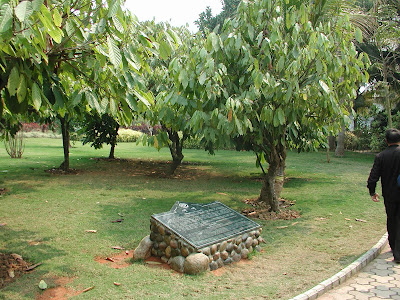Searching for cacao eggs
On offer Kew Gardens today: sun, easter eggs, spring flowers and this... This is one of the chocolate sculptures, part of the special Easter at Kew: Where chocolate grows on trees.
Early this morning grey squirrels were darting excitedly on the large chocolate-paint coated sculptures but after 9.30 am (opening time for humans) it was a few thousands kids.
Kew's website very conveniently tells you all about Theobroma cacao, the cocoa plant. The genus name (Theobroma) means 'food of the gods' and the species name (cacao) comes from some Aztec words meaning something like 'bitter water'.
According to this (our) website, Christopher Columbus thought the cocoa beans looked like goat droppings when he saw them piled onto canoe in Mexico. A decade or so later the Spaniards were a little more enthusiastic, leading to our chocolate obsession and in due course to this (yes I know the rabbit and fertility rituals probably came first but surely a rabbit that hands out chocolate eggs came after the Spanish brought chocolate back to Europe).
Sloane also collected the specimen from Jamaica that Carl Linnaeus examined and used to give cocoa its scientific name. So yes chocolate does grow on trees. There are Cacao Trees in the glasshouses at Kew but my picture below is of a small grove in the Xishuangbanna Tropical Flowers and Plants Garden in southern China.




Comments